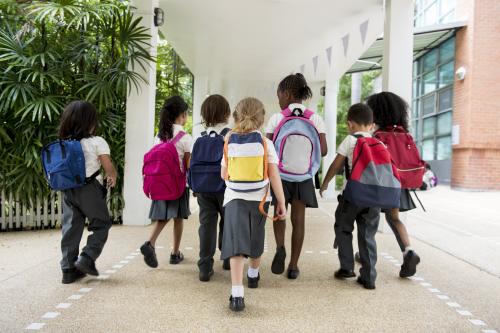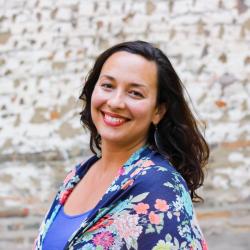This post is part of the “Community Schools Leader Insights” series in which Brookings is sharing the experiences of people in the thick of community schools and who are making strides toward student success through the unique strengths of the local community.
All 65 of greater Cincinnati’s schools are community learning centers, Ohio’s name for community schools.
Cincinnati Public Schools (CPS) is Ohio’s second largest school district. While it includes urban populations, it also covers a larger area called Greater Cincinnati, which includes rural communities in Appalachia. In the 91-square-mile area, CPS counts 36,000 students in preschool to 12th grade attending 65 schools. CPS’s school board passed a policy in 2001 to turn all 65 district schools into community schools (or community learning centers). Community schools are created through a strategy and shared vision for transforming schools and accelerating student success based on the unique needs and strengths of local communities.
Each school has a resource coordinator with a partner lead agency. These schools have built strong relationships with local families and partners along the way, which have resulted neighborhood development that students have participated in through project-based learning. There have been a range of academic improvements as a result, as well as many benefits to local neighborhoods.
Prior to community learning centers introduction, CPS had been facing a major enrollment decline, from 90,000 students in the 1970s to 45,000 in 1999, with a projection of 22,000 by 2010. Many parents were sending their children to private and parochial schools, which affected the public school budget and contributed to a cycle of disinvestment and disengagement.
Research from 2006-15 showed that Cincinnati’s move to community schools helped contribute to significant improvements. The achievement gap between Black and white students was reduced from 14.5 percent to 4.5 percent, and graduation rates have increased almost 7 percentage points over four years to 77.9 percent in 2018. The graduation rate has risen to 82.3 percent as of 2020. CPS community learning centers operate in alignment with the Ohio Department of Education’s College, Career, and Workforce Development measures. While core curriculum remains the same, the teaching strategies adopted by many community learning centers incorporate experiential and project-based learning, as well as engagement strategies that have wider implications for the community as a whole.
Student Tris’Shay Brown interviews CPS superintendent Iranetta Rayborn Wright.
The success of a school and the success of a neighborhood are inextricably linked
The emergence of community schools in Cincinnati has been tied to neighborhood success from the beginning. The CPS website states this connection: “The goal of Community Learning Centers is to support student achievement while revitalizing neighborhoods and maximizing the community’s return on its investment in public schools.” As CPS worked to improve enrollment in the early 2000s, an engagement process focused on rebuilding connection and trust with families that no longer sent their children to CPS began in each neighborhood asking the two questions: “What would make this the kind of school to which you would send your child?” and “What would make this the kind of neighborhood you want for your children and grandchildren?”
Located in Greater Cincinnati, the Lower Price Hill neighborhood is as much an Appalachian community as an urban one, and nearly half of its residents live below the poverty line. As the neighborhood faced disinvestment and vacancy, several neighborhood plans made by developers to improve Lower Price Hill had not been implemented or didn’t impact the neighborhood to the extent hoped. The one major bright spot was the local Oyler School, a community learning center that both served as the neighborhood’s hub and demonstrated its potential for growth and change.
Lower Price Hill needed the kind of engagement that Oyler School was already positioned to do as a community learning center. Consequently, CPS started working with Darlene Kamine to develop the community learning centers through neighborhood by neighborhood community engagement in 2000. Kamine subsequently became the executive director of the Community Learning Center Institute (CLCI) in 2009, focusing initially on Oyler School and subsequently leading deep dive community engagements in additional neighborhoods.
Kamine hired Adelyn Hall, who has been the director of School Center Neighborhood Development for the CLCI since 2015. Hall has a master’s in urban planning from the University of Cincinnati that she uses to bring together community school strategies with holistic neighborhood development. She led the Oyler School community engagement plan that was focused on the improvement of the neighborhood and advancement of families and led to the Lower Price Hill neighborhood plan that has driven about $100 million in neighborhood investment. The investment resulted in restoring quality affordable housing and single-family homes, 350 new jobs, a new nonprofit grocery store, and strategies with the ultimate goal of improving the educational outcomes and well-being for students and families.
Oyler media arts student taking pictures of groundbreaking new affordable apartments in Lower Price Hill.
Place-based learning in Lower Price Hill and Sayler Park
Students were also key to implementing the plan through project-based and placed-based learning by creating a logo and brand for the neighborhood, as shown in this short film by MediaSutra and the Partnership for the Future of Learning. In the film, Cynthia Ford, former president of the Lower Price Hill Community Council, says, “The students took more than a half a year of school working with the marketing people from Nehemiah to develop brands… and they came up with several ideas for potential logos for the neighborhood.” The project contributed to the ability of students to acquire real-world skills, such as marketing and neighborhood development as part of their classroom learning experience.
The revitalization of the school newspaper, the Oyler Griffin, is another example of place-based learning. Ten years ago, a retired teacher who grew up in Lower Price Hill—and former student editor of the paper—taught a class with a cooperating teacher to restart the paper as both a school and community paper alongside students. The students published stories that the mainstream press didn’t cover about their neighborhood, including the toxic environmental conditions from nearby industry and the regional sewer district. The paper was so popular that neighborhood residents began waiting on their porches for a student to deliver their printed copy.
Student members of The Griffin conducting an interview.
The impact of this hands-on, real-life learning then led to another deep dive engagement process devoted to planning for the improvement of the academic program, which brought unanimous support from the school community to organize the curriculum around a Media Arts and Communications Pathway in k-12. The goal of this pathway is to reinforce the basic academic skills through broadcasting, podcasting, videography, photography, creative writing, and journalism—all integrated into the curriculum and extracurriculars across grade levels. To do this, CLCI hired a graduate of the Ohio University Scripps School of Journalism to lead the program, both in the classroom and beyond the school day. The Griffin newspaper continues in an online format and a fully equipped broadcast studio is launching this year, with plans for regular news and programming for the neighborhood.
Experiential learning connected to Greater Cincinnati neighborhoods demonstrates that when school and community resources are organized around student success, they are more efficient and effective at boosting educational outcomes, as well as improving the neighborhood as a whole. Kamine says, “Genuine family engagement means helping families thrive so that their children can thrive. That means education can’t be separated from family economic stability, stable housing and increased homeownership, health care, and neighborhood vitality.”
Community learning centers in Greater Cincinnati have become a comprehensive way of organizing school and community resources around student success. The holistic approach to both education and a wide range of community needs has resulted in an effective way of boosting educational outcomes and improving the neighborhood as a whole.
Photo credits: Community Learning Center Institute.









Commentary
Greater Cincinnati’s community learning centers lead place-based learning and holistic neighborhood development
Community Schools Leader Insights
November 22, 2022